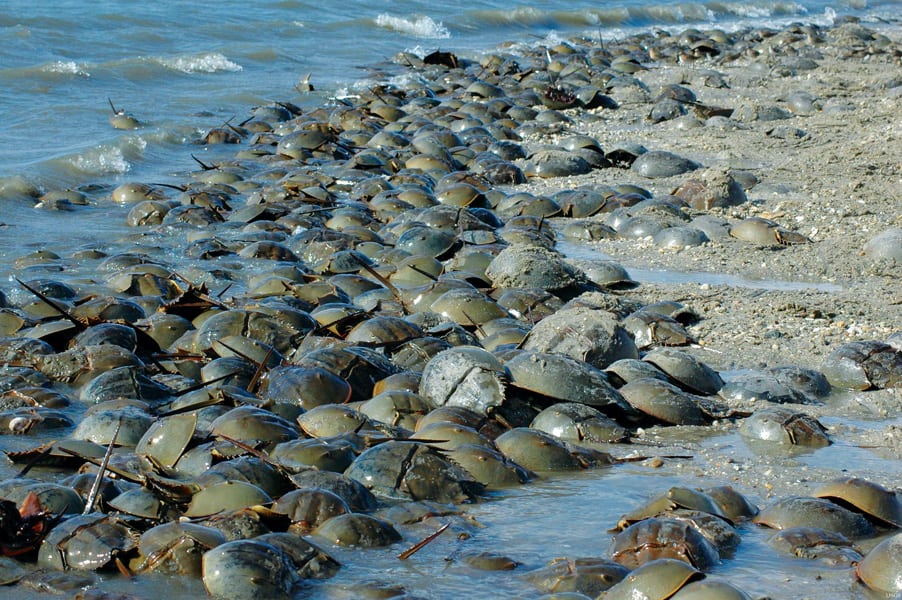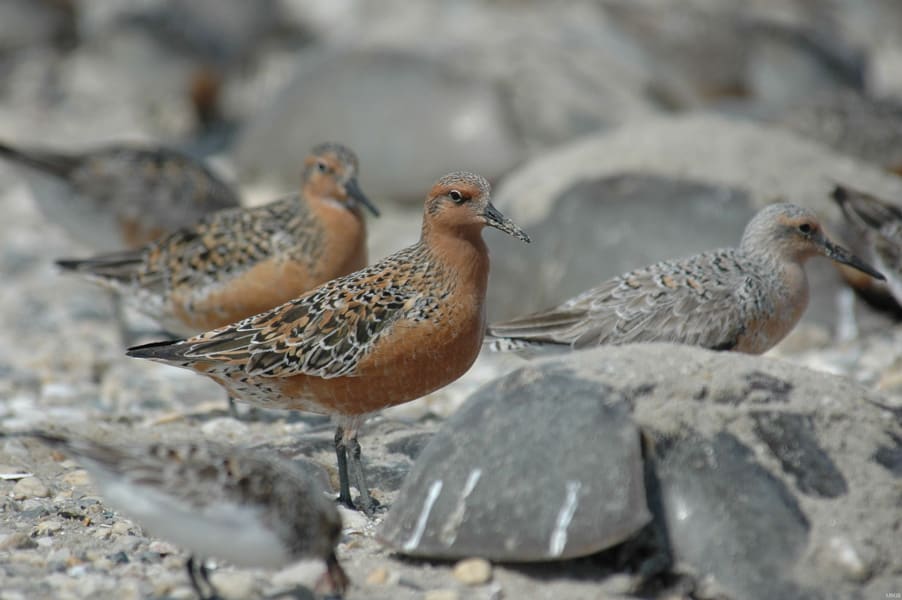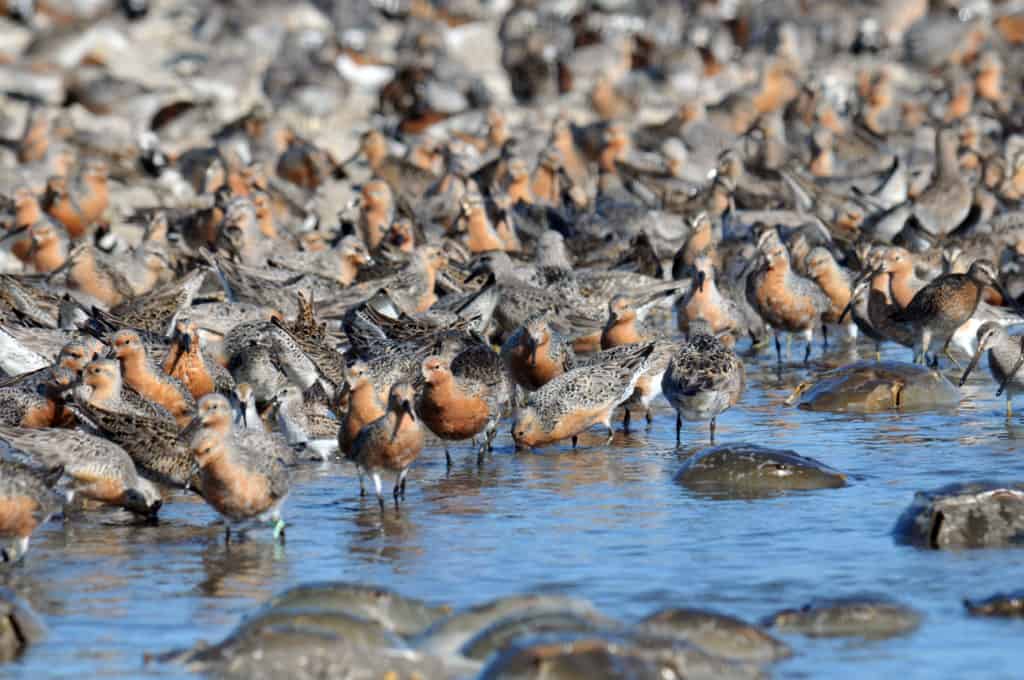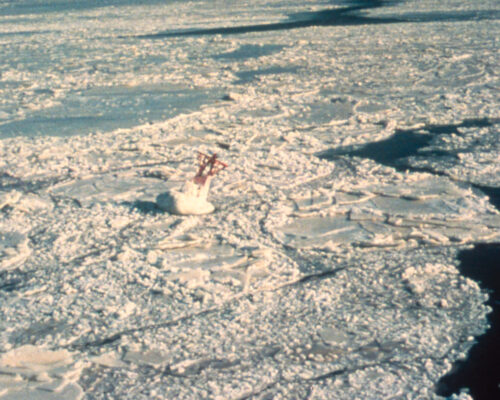Horseshoe crabs return to the Bay, along with their avian companions.
It’s late spring, and under a full moon rendering the Delaware Bay a palette of glittering mica, the beach is alive. What should be a miles-long ribbon of placid silver sand instead appears to be covered with brown rocks, and the rocks are moving.
Horseshoe crabs are here to spawn. By the hundreds of thousands, night after night under this spring moon (as long as the bay is relatively calm), they will crawl up this beach in unruly, clumsy piles, each female capable of laying up to 100,000 eggs over several nights. It is our region’s very own version of the arribada—arrival—a primeval compulsion propelled by the tide, moon, and season, and nowhere in the world does it occur as dramatically and significantly as here.
Still, it’s only half of the story. Just as the turn of the season has pulled these ancient creatures from the sea to this beach, so it has drawn by the tens of thousands a robin-sized bird on an epic migration of some 9,000 miles from the bottom of the globe to the top—Tierra del Fuego to the Arctic. On wings only 20 inches across, the rufa red knots can fly 1,500 miles at a stretch. By the time they arrive at the Delaware Bay, most of them have flown directly from Brazil nonstop, their reserves of body fat utterly spent. Unerringly they arrive for this one thing: the nutrient-dense, easily digestible eggs of the horseshoe crab, which they can find only here, only now.
So, this is a story of a relationship, one written both in a precise moment and over ages of time. It’s a story of decimation and survival—how overfishing horseshoe crabs contributed to a more than 75-percent population decline in rufa red knots (now a federally threatened species) from the 1980s to the 2000s.
It’s also a story of how this relationship prompted the first plan of its kind for an East Coast marine resource—an adaptive resource management, or ARM, framework—that acknowledges the interconnectedness of two species and seeks the best way to manage one to support the other, constantly adjusting based on consistent monitoring and assessment of both.
This sounds a lot easier than it is. By most accounts, it may be succeeding. But first, some history—specifically, a few million years’ worth.

The U.S. Fish and Wildlife Service (FWS) calls the horseshoe crab a living fossil. Relatively unchanged for at least 350 million years, Limulus polyphemus—so named for the mythical one-eyed cyclops Polyphemus because one of their many eyes appears as a single cluster in the middle of what could be considered their foreheads—is, if nothing else, a survivor. Misnamed, it’s actually related to spiders and scorpions, not crustaceans.
Mostly, they crawl around on the bottom munching marine worms and shellfish such as razor clams. Molting through their first decade, it takes them that long to reach sexual maturity, the females a year later than the males. They can live to be about 20 years old.
Four species exist worldwide, but only one—the most abundant—is in North America, and it ranges from Maine to the Yucatan Peninsula. Elsewhere, its numbers are in trouble. Found mostly in Southeast Asia, the remaining three species are imperiled due to a variety of factors, among them overfishing and loss of spawning habitat. Last year, the International Union for Conservation of Nature listed one of them, known as the tri-spine horseshoe crab, found largely in China, as endangered.
Despite its humble appearance and demeanor, few species have been studied as thoroughly as the horseshoe crab, and this is because of its utterly unique attributes. Among those are its eyes. It has ten of them—some of them clusters of photoreceptors on its body including its bayonet of a tail, and they are remarkably sensitive. According to the FWS, “Two large compound eyes on the prosoma [head] are sensitive to polarized light and can magnify sunlight 10 times. A pair of simple eyes on the forward side of the prosoma can sense ultraviolet light from the moon.” In 1967, Dr. H. Keffner Hartline shared the Nobel Prize in Physiology or Medicine for his study of the optic nerves of the horseshoe crab’s lateral eyes, which provided new understanding into the workings of the retina.
But while its eyes are astonishing, what’s truly mind-blowing about horseshoe crabs is this simple fact: “There is not a single person alive on the face of the earth who has not been touched by the horseshoe crab, because every time someone gets a shot, whether it be a vaccine or a therapeutic product or an IV saline solution or any implanted device, even vitamins that are injected—all of that is tested for endotoxin using LAL.” That’s from Allen Burgenson, an LAL industry representative to the Horseshoe Crab Advisory Panel of the Atlantic States Marine Fisheries Commission (ASMFC).
LAL is Limulus Amebocyte Lysate, a component in the crabs’ unique, blue, copper-based blood. This clotting substance has the ability to detect bacterial endotoxin at an unparalleled level of sensitivity. In 1977, the Food and Drug Administration approved LAL as the mandatory way to test biological products and medical devices for endotoxin.
In the U.S., four companies are federally approved to manufacture and sell LAL. They do this by harvesting horseshoe crabs, taking about a third of their blood, then releasing them back to the wild. The ASMFC estimates 15 percent of crabs don’t survive this procedure. But in Asia, where a substance called TAL is those species’ equivalent, the process is entirely fatal; the crabs are exsanguinated, then used for food and other products.
Long before LAL was a blue glimmer in scientists’ eyes, horseshoe crabs were harvested by the millions in New Jersey and Delaware. Easy to catch, they were tossed in open pens, dried, then ground to make fertilizer. By the 1960s this fishery had ended, but in the 1990s, demand for the crabs picked up again, this time as bait for eel and whelk. Fishermen found that females in particular caught the most eels.
Landings of 44 million pounds annually from Maine to Florida between 1971 and 1975 climbed to 3.5 billion pounds by 1997, according to the National Marine Fisheries Service. Resource managers grew concerned, not least because there were no accurate population assessments of horseshoe crabs.
Meanwhile, surveys of red knots began an alarming trend. According to data in the FWS Recovery Outline for the rufa red knot, one-day peak counts gathered through aerial surveys of red knots in the Delaware Bay fell from a high of 95,530 in 1982 to as low as 12,375 in 2007. Numbers in the birds’ wintering grounds in Argentina and Chile also plummeted, from a high in 1995 of about 75,000 to a low in 2011 of about 10,000. While various factors contributed to this population crash—including habitat loss and predation—scientists pointed to a lack of food at the critical point in their northbound migration through the mid-Atlantic, and the Delaware Bay specifically, as a major cause.

“Nearly 90 percent of the entire population of the Red Knot subspecies rufa can be present on the bay in a single day,” noted the Cornell Lab of Ornithology. “The reduction in food available to the knots because of the heavy harvesting of horseshoe crabs is in part responsible for a sharp decline in Red Knot populations.”
The ASMFC, which represents 15 coastal states coastwide, began capping states’ harvest of horseshoe crabs in 1999 when it implemented its first multi-state horseshoe crab management plan. Subsequent innovations in bait bags also helped lower by as much as 50 to 75 percent the amount of crabs needed for the whelk and eel bait fishery. But the biggest innovation happened in 2012, when the commission approved the Adaptive Resources Management (ARM) framework as part of the management plan.
“It’s one of the few that I know of ecosystem models that are being used where you’re combining multiple species to make management decisions,” says Mike Schmidtke, ASMFC Fishery Management Plan Coordinator. Unlike traditional methods, which usually focus on one species, the ARM monitors data of two species whose life cycles are entwined, and the system model makes annual assessments based on those data.
“We check that every year, and every year we go back and say, which harvest package do we recommend?” says Eric Hallerman, a professor of fish conservation at Virginia Tech who’s on the ASMFC Delaware Bay Ecosystem Technical Committee. “It’s exciting. To get folks to buy in and live by it and manage by it, it takes a while. I’ve been proud to be part of this.”
Hallerman’s role in the ARM is vital, because since 2002, his Virginia Tech Horseshoe Crab Trawl Survey has been the definitive longitudinal survey of horseshoe crab numbers in the mid-Atlantic and lower Delaware Bay—despite a hiatus between 2012 and 2015 due to a lack of funding. (The survey is so vital that several of the region’s congressional representatives are working to remove it from the vagaries of the annual appropriations process and make it part of the NOAA Fisheries annual budget.) In addition to counting and measuring crabs, researchers now can determine whether they have spawned and estimate whether they’re immature, newly mature, or mature. This provides an assessment of potential abundance going forward, Hallerman says.
“That information is critical from a modeling standpoint,” Schmidtke says. “That let us, in the 2019 assessment, to have an actual population model for the Delaware Bay region…That was a big step that the science took because that was the first time we’ve been able to get an actual numeric estimate for the number of horseshoe crabs in a given population, as opposed to just looking at a transit increase or decrease.”
In 1998, The Ecological Research & Development Group (ERDG), a 501(c)3 non-profit wildlife conservation organization founded in 1995 with a focus on horseshoe crab conservation, launched its highly successful Just Flip ‘Em Program to bring attention to the high mortality the crabs incur from being stranded up-side-down during spawning and to encourage, through a simple act of compassion, an appreciation for this remarkable creature who will not survive public indifference.
The horseshoecrab.org web page is a rich source of information on the crabs including how we can engage in conservation and appreciation by reporting sightings and especially tagged crabs and by joining the annual survey. ERDG also offers educational programs for classroom use and sponsors competitions to celebrate these fascinating creatures.
Data from the trawl survey are combined with data from two research teams—one in New Jersey and one in Delaware—that monitor red knot passage population. While the initial ARM framework used aerial surveys, in 2011, this more refined assessment began, which uses both physical recapture of birds and sightings of tagged birds, says Jim Lyons, a research ecologist with the U.S. Geological Survey at Patuxent Wildlife Research Center who’s on the ARM working group, a subcommittee of the ASMFC Delaware Bay Ecosystem Technical Committee.
“I analyze their data, and that estimates how many red knots stopped in Delaware Bay that year,” he says. “That passage population goes directly into the decision-making process for the crab harvest recommendation.”
The good news is that numbers of both species appear to be stabilizing. The ASMFC’s 2019 Benchmark Stock Assessment found that in the Delaware Bay, horseshoe crab abundance was neutral, while New York was in poor condition, and the Southeast is in good condition. In fall 2019, the commission’s Horseshoe Crab Management Board approved a harvest limit of 500,000 male crabs and zero females for the 2020 season. (Schmidtke notes that landings have not approached harvest quotas in years, which indicates the pressure on the fishery has eased.)
“We’re guardedly optimistic,” Hallerman says. “I am speaking, I think, for the majority of us. We’re not out of the woods yet, but I think we’re starting to see a recovery.”
In its Recovery Outline for the Rufa Red Knot, the FWS notes that while threats to the birds’ survival continue—high among them climate change and habitat loss—the ARM is having a positive effect. “Under the current management framework, the present horseshoe crab harvest is not considered a threat to the red knot.”
Lyons says that in 2011, the passage surveys estimated 43,570 red knots, “and it’s been fairly steady since then with some variation from year to year. Last year was 45,133.”
It’s not all clear on the horizon. The FWS report noted that inconsistent funding for the necessary surveys could imperil the ARM. And in its 2019 Horseshoe Crab Benchmark Stock Assessment, the ASMFC noted concerns about bycatch, something researchers know little about yet: “The magnitude of horseshoe crab discards in the targeted horseshoe crab fishery and other fisheries is potentially the most important uncertainty and highest priority research recommendation identified in the assessment to improve abundance estimates. Preliminary results show discard mortality may be comparable to or greater than combined mortality from other sources.” Meanwhile, incessant human pressure on shoreline habitat is an issue that shows no sign of abating. When shorelines are rip-rapped or developed, crab spawning habitat is lost.
But horseshoe crabs and rufa red knots, through the ARM framework, are providing resource managers, scientists, and others new insights into how to approach the holistic management of species within interconnected ecosystems—the intertwined stories of completely different animals.
“It absolutely is very cool conceptually,” Schmidtke says, “If you think about it and the implications for it, and you see the interconnectivity, and how so many different things impact each other.”



